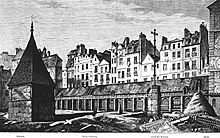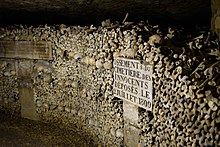Cimetière des Innocents
The Cimetière des Innocents (Eng. "Cemetery of the Innocents"), which was once in the Quartier des Halles , was the largest inner-city cemetery in Paris until the end of the 18th century . It got its name from the formerly neighboring church "Aux Saints-Innocents", named after the festival of the "innocent children" , which is celebrated in the Catholic liturgy on December 28th.
history

Middle Ages and Early Modern Times
From the time of the Merovingians , the site of the later Cimetière des Innocents served as a burial place. Philip II , King of France from 1180 to 1223, who expanded Paris into his residence, had the cemetery expanded and in 1186 enclosed by a surrounding wall.
From the Middle Ages to the 18th century, the deceased of all 22 parishes in Paris were buried there, as well as those of the Hôtel-Dieu , the plague victims, those who drowned in the Seine and the unknown dead found in the streets. Depending on whether one reckons with an average of 2000 burials annually for the six centuries from 1186 to the closure in 1780 (according to Henri Bayard 1842) or with at least 3000 annually (according to more recent projections) one comes to up to 2 million Parisians living on the Cimetière des Innocents were buried.
Since the 14th century, mass burials had to be carried out in times of famine and epidemics . Despite famine and epidemics, the population of Paris rose to around 720,000 by the end of the 17th century. The capacity of the cemetery was nowhere near enough. Ossuary was installed, and the time the dead lay in the cemetery was shortened to such an extent that the corpses could no longer completely rot. When in 1779 some residents in the adjoining Rue de la Lingerie had suffocated from the seeping gases , the cemetery was closed forever on November 1st, 1780 at the behest of the police director. At that time, the level of the cemetery area was already two and a half meters above that of the surrounding streets.
The lifting of the cemetery
In the period that followed, the remaining bones were taken to the city's catacombs , where they can still be viewed today, piled up in piles.
After the complete evacuation, a Viktualienmarkt , i.e. a market for food, was held on the heavily contaminated site . This was later integrated into the large Parisian market halls ( Les Halles ), which at the time of the Paris city redevelopment under Napoleon III. were extended by covered pavilions. In the 1970s, these were torn down again and the huge Forum des Halles shopping center was set up. At the site of the former cemetery at the intersection of Rue Berger and Rue Saint-Denis , the Place des Innocents and the Fontaine des Innocents are a reminder of the past.
Consequential effects
The example of the abolition of this inner-city cemetery caught on. It heralded the end of many other inner-city cemeteries, especially in the fast-growing metropolises. In Hamburg , the Dammtor cemeteries were closed in the middle of the 19th century , and the Planten un Blomen park ( plants and flowers ) was created in their place . The uncovered bones were brought to the Ohlsdorf cemetery , which is still located on the eastern outskirts and is the largest park cemetery in the world.
The dance of death
The cemetery became known, among other things, for one of the oldest depictions of a Danse macabre in a fresco , which was created between 1424 and 1425 under the arcades on the inside of the cemetery wall. Over a length of about 35 meters, 30 almost life-size dance couples were shown: Death personified as a skeleton accompanied the most important representatives of the spiritual and secular classes with dance steps from this life. Although the mural was destroyed in 1669 because the street was widened, the individual scenes are largely known from the La Danse macabre cycle published in 1485 by the Parisian printer Guyot Marchant , a series of woodcuts based on the Aux Innocents dance of death with the associated dialogue verses.
Buried personalities
- Jean Clouet (1480–1541), Renaissance painter
- Jean de La Fontaine (1621–1695), writer
- Louis Marchand (1669–1732), harpsichordist, organist and composer
- Jean-Baptiste Pater (1695–1736), painter
- Jean-Baptiste Barrière (1707–1747), cellist and composer
- Louise Julie de Mailly-Nesle (1710–1751), mistress of Louis XV.
The Cimetière des Innocents as a literary setting
- In the novel Perfume by Patrick Suskind (1985) the main character Jean-Baptiste Grenouille sees on a directly to the Cimetiere des Innocents adjoining fish market the light of day and dies at the end of the book in the cemetery.
- In the vampire novel The Prince of Darkness by Anne Rice (1985), the old vampire order resides under Armand's leadership on the Cimetière des Innocents .
- In the historical novel Cemetery of the Innocents by Andrew Miller (original Pure , 2011), the young engineer, Jean-Baptiste Baratte instructed to clear the Cimetiere des Innocents, "We will overcome the past. History has hindered us long enough. "
literature
- Christophe Girot: Between Space and Place , lecture in Stuttgart 1998 ( published as a brochure by the DVA Foundation in September 2000, not available in bookshops).
- Hans Georg Wehrens: The dance of death in the Alemannic language area. "I have to do it - and don't know what" . Schnell & Steiner, Regensburg 2012, especially p. 19ff. ISBN 978-3-7954-2563-0 .
Quote
“A permanent uprooting took place here. […] What makes this 'Fontaine des Innocents' so special is that its former subsoil, the soil layer of the old Cimetière des Innocents cemetery, has been removed and the concrete layers for a shopping center and the RER station 'Les Halles' have been inserted in its place. [...] You are in a destroyed place. […] All people, regardless of their origin, instinctively felt that the place was robbed of its history, that there was no longer any respect for the dead, that everything was just fiction, yes, artificially created. [...] A district where the living are driven away and the dead are mocked no longer seems to attach great importance to people. […] The epoch of 'des Innocents' thus stands for the downfall of a piece of Parisian life that was primarily based on the collective memory of a place and its people. "
Footnotes
- ^ Jean-François Large: Des Halles au Forum. Métamorphose au coeur de Paris . Editions L'Harmattan, Paris 1992. ISBN 2-296-27120-0 . P. 19.
- ^ Henri Bayard: Mémoires sur la topographie médicale du 4e arrondissement de Paris, recherches historiques et statistiques sur les conditions d'hygiéniques des quartiers qui composent cet arrondissement . Baillière, Paris 1842. p. 54.
- ^ Julien Philippe de Gaulle: Nouvelle histoire de Paris et de ses environs . Vol. 4, Pourrat, Paris 1839. p. 430.
- ^ Antoine Cadet de Vaux : Mémoire historique et physique sur le Cimetière des Innocents . In: Journal de physique, de chemie, d'histoire naturelle et des arts , vol. 22 (1783), pp. 409-417.
- ↑ Jean Eugène Dezeimeris: Dictionnaire historique de la médecine ancienne et moderne, ou précis de l'histoire générale, technologique et littéraire de la médecine . Vol. 4, Béchet Jeune et Labé, Paris 1839. p. 264.
- ↑ Martin Halter: Wrecking Ball of Enlightenment . In: Frankfurter Allgemeine Zeitung , July 27, 2013, p. 33.
- ↑ Christophe Girot: Between Space and Place , p. 11ff.
Web links
Coordinates: 48 ° 51 ′ 38 " N , 2 ° 20 ′ 52" E




